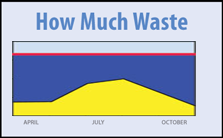Canada's Rivers at Risk
Canada’s most precious natural resource – fresh water – is in jeopardy due to the effects of climate change and growing demands for water.
To shed light on how these pressures are affecting our rivers, World Wildlife Fund-Canada (WWF-Canada) has released a report entitled Canada’s Rivers at Risk.
The report provides a foundation for WWF-Canada’s freshwater program, which aims to ensure we keep our rivers flowing, for nature and for people.
Canada ranks among the world’s top nations in terms of renewable water supply. Such global treasures, says WWF-Canada, make this country enviable in an increasingly thirsty and warming world.
But this perspective is misleading, claims the report. Water is constantly moving, and it is this constant motion – the flow of water – that provides insight into the availability of fresh water and the health of freshwater ecosystems.
Many of the world’s river flows are at risk from the impacts of producing more food, generating electricity, fuelling industry and quenching the thirst of expanding cities. Climate change further compounds these problems by introducing new threats and uncertainties.
WWF-Canada maintains the three key threats to river flow are climate change, water withdrawals and diversions, and flow regulation and fragmentation.
Climate change presents a challenging new dimension to water management in Canada.
Melting glaciers, shifting precipitation patterns, and increasingly intense and frequent droughts and floods are among the effects of climate change on river flows. Studies show that maximum river flows are generally decreasing across most of the country. If these patterns continue as predicted, Canada’s freshwater future will become increasingly uncertain.
Demand for water is expected to increase as temperatures rise, making protection of environmental flows even more challenging.
Water is withdrawn from rivers to produce food, fuel industry, urban irrigation and supply municipalities with drinking water.
Irrigated agriculture is of particular concern as the majority of water withdrawn is consumed in that process, making it unavailable to support the river ecosystem or for further use downstream.
When water is withdrawn is crucial – taking water during periods of low flow and drought typically has a greater impact on river health that taking water during other periods.
Dams and other instream infrastructure such as locks, weirs and dykes can alter flow regimes by changing the quantity, timing and quality of water that flows through rivers and streams. These developments are constructed to produce hydropower, control flooding and store water for irrigation or urban consumption.
However, they also alter a river’s natural flow and sever connections between different parts of a river system and its watershed, resulting in negative effects on freshwater eco-systems and species.


